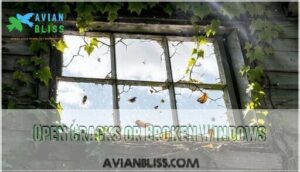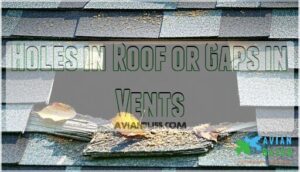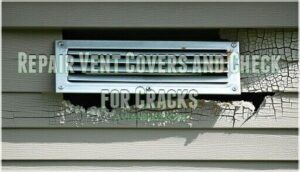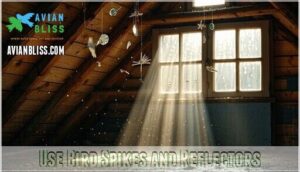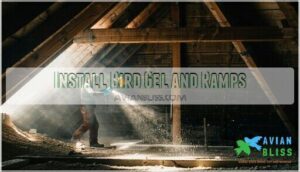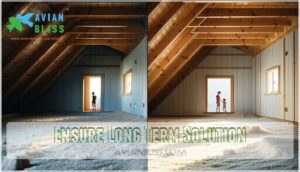This site is supported by our readers. We may earn a commission, at no cost to you, if you purchase through links.
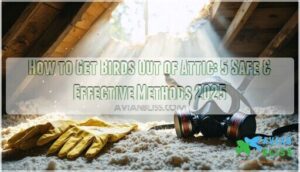 To get birds out of your attic safely, you’ll need to identify their entry points and use humane removal methods. Start by wearing protective gear and locating openings like damaged vents, roof gaps, or broken windows where birds entered.
To get birds out of your attic safely, you’ll need to identify their entry points and use humane removal methods. Start by wearing protective gear and locating openings like damaged vents, roof gaps, or broken windows where birds entered.
Install one-way exclusion devices that let birds exit but prevent re-entry, or use live traps with appropriate bait. Once they’re out, seal all entry points with hardware cloth, metal flashing, or wire mesh.
Clean up droppings thoroughly and apply bird repellents like reflective tape or essential oils around the area. The key is patience—rushing the process often backfires, leaving you back where you started with persistent feathered tenants who know exactly how to exploit your home’s weaknesses, requiring protective gear and understanding of entry points to effectively use one-way exclusion devices.
Table Of Contents
- Key Takeaways
- Remove Birds Safely
- Get Birds Out Attic
- Identify Entry Points
- Prevent Future Infestations
- Ensure Long Term Solution
- Frequently Asked Questions (FAQs)
- Do birds leave your attic on their own?
- How do you keep birds out of your attic?
- Why should you get rid of Attic birds?
- What happens if you remove birds from your attic?
- How to evict birds from Attic?
- What to do if you have a bird nest in your attic?
- Can birds in the attic cause damage?
- What’s the best way to get a bird out of a building?
- How much does it cost to have birds removed from an attic?
- How to get squirrels and birds out of the attic?
- Conclusion
Key Takeaways
- Wear protective gear including gloves, N95 masks, and safety goggles to protect yourself from disease-carrying bird droppings before starting any removal work.
- Install one-way exclusion devices that allow birds to exit but prevent re-entry, or use live traps with birdseed bait to capture birds humanely.
- Seal all entry points with hardware cloth, metal flashing, or wire mesh after removal to prevent future infestations – check vents, roof gaps, and damaged areas.
- Clean and decontaminate thoroughly after removal, applying bird repellents like essential oils or reflective tape around the area to discourage return visits.
Remove Birds Safely
When you’re ready to remove birds from your attic, you’ll need proper safety equipment and the right approach to protect both yourself and the birds.
Start by gathering protective gear like gloves and masks, then choose between humane trapping methods or natural repellents to encourage the birds to leave on their own.
Protective Gear and Gloves
Before you handle birds in attic situations, proper protective gear is your first line of defense against bird diseases and health risks.
Bird droppings attic contamination carries serious pathogens, making safe removal practices essential.
**Protect yourself first—bird droppings harbor dangerous diseases that demand proper safety gear.
Essential protective equipment for attic bird removal:
- Heavy-duty rubber gloves – Choose thick glove material that prevents punctures from beaks or claws
- N95 respirator mask – Blocks airborne particles from disturbed droppings during handling nests
- Long-sleeved clothing – Covers exposed skin to prevent direct contact with contaminated surfaces
- Safety goggles – Protects eyes from debris and prevents disease transmission through mucous membranes
Always practice proper gear disposal after each attic visit to maintain disease prevention standards.
You can find a variety of masks online.
Cage or Net for Trapping
Once you’ve got your protective gear sorted, it’s time to set up your trap. Cage traps work best when you choose the right bait selection and trap placement.
Position your live trap near where you’ve spotted bird activity, using seeds as bait. Humane trapping requires patience and proper trap maintenance.
Many people find success using specialized bird enclosures for this purpose.
| Trap Setup | Best Practices | Safety Tips |
|---|---|---|
| Bait Selection | Mixed birdseed works well | Avoid chocolate or bread |
| Trap Placement | Near entry points | Away from direct sunlight |
| Humane Handling | Use gloves always | Move slowly and calmly |
| Release Location | 1+ miles from home | Safe, wooded areas |
Essential Oils as Repellents
After trapping proves challenging, natural bird deterrents offer a gentler approach.
Essential oils like peppermint, citronella, and lemon create effective bird repellent scents that irritate birds’ sensitive systems.
Mix a few drops with water for DIY blends, applying via spray or soaked cotton balls.
Peppermint oil repels birds due to its strong scent.
Reapply frequently since scent duration diminishes quickly outdoors, especially after rain, as this is a critical step to maintain the effective bird repellent.
Mesh and Bird Gel for Prevention
Mesh barriers and bird gel offer reliable attic bird prevention solutions.
Install galvanized hardware cloth with 1/4-inch openings over vents and entry points for lasting birds in attic protection. Bird repellent gel deters birds because of its ultraviolet fire appearance.
Key prevention methods:
- Mesh Durability: Stainless steel mesh provides years of bird proofing attic coverage
- Gel Application: Apply bird repellents to ledges using caulking gun techniques
- Cost Comparison: Mesh offers better long-term effectiveness than repeated gel treatments
These safe alternatives create physical barriers while maintaining proper attic ventilation.
Get Birds Out Attic
Once you’ve donned your protective gear, it’s time to actually remove the birds from your attic. Listen for bird sounds to locate where they’re nesting – chirping, scratching, or fluttering will guide you to their hideouts. Open all windows and doors to create clear exit routes before you begin any trapping methods.
If you find a bird has accidentally entered your chimney instead, remember to check for wing flapping sounds to confirm its location. Set up cage traps with birdseed near their activity areas. You can also use nets to capture birds, but work slowly to avoid startling them.
If you spot chicks in nests, wait until they’re old enough to fly before attempting nest relocation to nearby trees. Remember the health risks involved – bird droppings carry diseases, so never handle materials without gloves. Legal considerations matter too, as most species are protected.
Focus on humane bird removal rather than harsh tactics.
| Method | Best For |
|---|---|
| Cage Traps | Individual adult birds |
| Open Windows | Encouraging natural exit |
| Towel Capture | Small, accessible birds |
Identify Entry Points
Before you can remove birds from your attic, you need to find exactly how they’re getting inside.
Start by examining your home’s exterior during daylight hours, looking for damaged areas where birds could squeeze through openings as small as a quarter.
Open Cracks or Broken Windows
Small gaps can become major bird entry points into your attic.
Up to 70% of attic bird entry points occur through easily overlooked cracks and broken windows, with gaps as small as 1 inch providing access for various species.
Even tiny gaps you’d never notice become major highways for determined birds seeking warm attic shelter.
Key windowpane vulnerability areas to inspect:
- Wooden window frames – Older homes show 40% higher crack rates requiring immediate sealing materials for DIY repairs
- Storm-damaged panes – Weather damage increases bird entry points by 35%, making crack inspection essential for damage prevention
- Thermal gaps – Use visual inspection to detect invisible fissures that compromise your bird proofing efforts and create attic bird entry points
Regular sealing holes prevents future infestations.
Intentional Openings Like Attic Viewing Windows
Through attic viewing windows, birds discover convenient entry points that homeowners often overlook.
These intentional openings, found in 25% of pre-1980 homes, frequently lack protective screens.
Almost half of suburban attic infestations link to improperly sealed viewing windows, creating significant bird entry points requiring immediate bird control attic measures.
| Window Design | Security Concerns | Energy Efficiency |
|---|---|---|
| Standard viewing windows lack protective mesh | Gaps up to 2 inches allow bird access | Unsealed openings increase heating costs |
| Fine mesh screens reduce entry risk by 80% | Repeated use causes frame deterioration | Proper sealing improves insulation effectiveness |
| Aesthetic Impact varies with screen installation | Privacy Issues arise from damaged frames | Professional bird removal service addresses all concerns |
| Modern designs integrate bird control features | Entry points compromise home security | Sealed windows maintain temperature control |
Holes in Roof or Gaps in Vents
Your home’s roofing components face constant weather exposure, creating vulnerable spots where birds in attic problems begin.
Damaged or missing vent covers allow entry for birds, bats, and rodents through gaps exceeding 3/4 inch.
Roof hole repair becomes essential when water damage creates openings, while vent gap sealing prevents the 60% of bird infestations linked to utility penetrations.
Regular inspection frequency helps identify entry point size before birds establish nests, ensuring material durability of protective barriers maintains effective bird entry prevention.
Damaged Siding or Loose Shingles
Weather and age take their toll on exterior siding, creating unexpected bird entry prevention challenges.
Research shows 35% of residential bird entries occur through deteriorated siding or missing shingles.
During your siding inspection, look for warped panels and lifted shingles that create gaps several inches wide.
Annual roof damage assessments can reduce attic bird removal needs by 50% through early shingle repair and preventative measures.
Prevent Future Infestations
Once you’ve successfully removed birds from your attic, you’ll need to secure all entry points to prevent their return.
This essential step involves sealing openings, repairing damaged areas, and installing deterrents to keep your attic bird-free permanently.
Apply Metal Flashing or Wire Over Openings
Metal flashing covers block 99% of bird entry attempts when properly installed. After identifying entry points, you’ll need durable materials for effective birdproofing.
Wire mesh and metal flashing create permanent barriers that prevent birds in attic situations. Here’s your action plan for sealing gaps:
- Measure openings accurately before purchasing materials – gaps as small as 3/4 inch allow sparrows inside
- Install galvanized mesh screens over vents and holes for 95% reduction in bird intrusion
- Apply metal flashing to cover larger openings, ensuring tight fits that eliminate future entry points
Choose stainless steel or copper materials for maximum durability. Consider browsing a site for attic flashing products to find the right fit.
Full perimeter sealing decreases nesting incidents by 80% over two years, making this bird exclusion method highly effective for attic bird deterrent systems.
Repair Vent Covers and Check for Cracks
Your home’s vulnerable spots need attention. Check vent cover types like galvanized steel or plastic models for damage or warping.
Follow a crack identification guide to spot gaps around fascia boards and soffits. Heavy-duty stainless steel vent covers prevent bird access for at least ten years.
Choose sealing material options like exterior caulk for small openings. Understanding woodpecker drumming behavior can also help identify potential entry points.
DIY repair steps include replacing damaged covers before birds in attic become a bigger problem. This step is crucial for maintaining the integrity of your home and preventing further damage from woodpeckers.
Use Bird Spikes and Reflectors
Installing bird spikes on eaves and ledges delivers 98% deterrent effectiveness against common pest birds.
Position spikes where birds typically perch or roost.
Reflective objects like UV tape and mirrors create visual deterrents that reduce nesting attempts by 70%. These reflector types work by confusing birds’ vision and navigation.
Proper spike placement combined with strategic reflective materials provides long-term prevention for thorough bird control around your attic area.
Install Bird Gel and Ramps
Bird gel provides a sticky deterrent that makes landing uncomfortable for birds without harming them. Apply gel to beams, rafters, and potential perching spots in your attic.
Proper Surface Preparation guarantees maximum Product Longevity, with gel-based repellents offering six months of protection.
- Imagine never hearing scratching sounds above your bedroom again
- Picture your attic staying clean and free from messy bird droppings
- Feel confident knowing your family’s safe from disease-carrying parasites
- Enjoy peace of mind with long-lasting Bird Deterrence protection
- Save money by preventing costly damage to insulation and wiring
Ensure Long Term Solution
Successfully removing birds from your attic is just the first step in solving the problem permanently.
You’ll need to maintain regular inspections and follow proper decontamination procedures to prevent future infestations and protect your family’s health, which is a crucial step in ensuring the health of your family.
Regular Inspections and Maintenance
Keep your attic inspection routine simple but thorough.
Schedule quarterly checks to spot problems before they become expensive headaches. Examine areas where birds commonly enter and assess your current prevention measures.
| Inspection Focus | Maintenance Action |
|---|---|
| Roof Integrity | Check shingles, flashing, gaps |
| Vent Maintenance | Clean debris, secure screens |
| Sealing Cracks | Apply caulk to new openings |
| Gutter Cleaning | Remove nesting materials |
Regular attic maintenance prevents future bird invasions while protecting your home’s structural integrity.
Humane Removal and Management
The most effective humane bird removal prioritizes bird welfare while addressing your attic problem.
Professional wildlife experts guarantee safe trapping methods that don’t harm birds during removal. Proper nest relocation requires timing—wait until fledglings leave naturally when possible.
- Safe Trapping: Use cage traps with seeds, avoiding methods that could injure birds during capture
- Nest Relocation: Move empty nests to nearby trees only after confirming no eggs or chicks remain
- Ethical Deterrents: Apply bird-friendly repellents like essential oils rather than harmful chemicals
Deodorizing and Decontamination Services
After you’ve cleared out your unwanted guests, tackling bird droppings diseases and odor elimination becomes your next mission.
Attic cleaning requires thorough attic sanitation to restore air quality and guarantee disease prevention.
| Service Type | Target Issue | Expected Timeline |
|---|---|---|
| Dropping cleanup | Bird droppings diseases | 1-2 days |
| Odor elimination | Bird odors removal | 3-5 days |
| Parasite control | Mite and flea treatment | 1 week |
Professional decontamination services use specialized equipment to neutralize harmful pathogens and eliminate lingering bird odors that regular cleaning can’t handle.
Costs and Professional Help
When you weigh bird removal cost, professional help can save time and hassle.
Here’s what you should know:
- Removal costs range from $300–$1,000.
- Professional assistance includes safe, legal compliance.
- DIY vs Pro: DIY risks reinfestation and legal trouble.
- Choosing experts guarantees thorough bird removal services.
- Bird removal professionals offer warranties and follow-up.
Unexpected issues may require avian specialist expertise. Professional assistance includes safe, legal compliance. DIY vs Pro: DIY risks reinfestation and legal trouble.
Frequently Asked Questions (FAQs)
Do birds leave your attic on their own?
Birds don’t typically leave your attic on their own.
They’re drawn to the shelter, warmth, and safety your attic provides for nesting.
You’ll need to actively remove them through trapping or professional help.
How do you keep birds out of your attic?
Seal entry points with hardware cloth or mesh, repair damaged vents and soffits, install bird spikes on rooflines, use reflective tape deterrents, and maintain regular roof inspections.
Why should you get rid of Attic birds?
Attic birds aren’t just unwelcome guests—they’re health hazards carrying over 60 diseases through their droppings, including histoplasmosis and cryptococcosis. You’ll face respiratory issues, property damage, and parasite infestations.
What happens if you remove birds from your attic?
You’ll restore peace and eliminate health hazards from disease-carrying droppings. Your attic becomes cleaner, safer, and free from parasites like mites and fleas that birds bring.
How to evict birds from Attic?
Open windows during daylight, then play loud music to scare them toward exits. Use towels to gently capture stragglers or set cage traps with birdseed. Seal all entry points afterward.
What to do if you have a bird nest in your attic?
Like a delicate house of cards, discovering feathered tenants requires careful dismantling.
Wait until adult birds leave, then relocate the nest to nearby trees.
Seal entry points with mesh afterward to prevent their return.
Can birds in the attic cause damage?
Yes, birds in your attic can cause significant damage. They’ll tear insulation, peck wood structures, damage electrical wiring, and leave disease-carrying droppings that create health hazards for you.
What’s the best way to get a bird out of a building?
Nothing’s more frustrating than a feathered intruder disrupting your peace.
You’ll want to open all windows and doors, then gently guide the bird toward these exits using a broom or towel, creating a clear escape path while staying calm.
How much does it cost to have birds removed from an attic?
Professional bird removal from attics typically costs $300-$800, depending on infestation size, damage extent, and your location. You’ll pay more for protected species requiring permits or extensive cleanup services.
How to get squirrels and birds out of the attic?
Remove squirrels and birds by sealing entry points with hardware cloth, playing loud music near open windows, using live traps with seeds, and applying peppermint oil repellent around access areas.
Conclusion
Ironically, getting these uninvited aerial residents to leave requires more finesse than force.
Successfully learning how to get birds out of attic means combining patience with proven techniques. You’ll need protective gear, one-way exclusion devices, and thorough sealing of entry points.
Regular inspections prevent future problems. Remember, humane removal methods work better than aggressive tactics.
Professional help may be necessary for severe infestations or when dealing with protected species.
- https://buy.geni.us/Proxy.ashx?tsid=107655&track=homesandgardens-us-3548789026289663392&GR_URL=https%3A%2F%2Fwww.walmart.com%2Fip%2FLANNEY-Stainless-Steel-Bird-Squirrel-Deterrent-Spikes-10-Strips-11-ft-Unassembled-Spikes%2F271898283
- https://www.carolinapest.com/bird-attic-removal/
- https://www.flockingaround.com/post/how-to-help-injured-birds
- https://www.birdbgone.com/bird-chase-super-sonic/
- https://www.housedigest.com/1457738/repel-birds-pest-peppermint-essential-oil/


